The days of traditional PR tactics are not numbered, but agencies and brands in 2024 should consider trying out new approaches to get the biggest bang for their buck. Influencers are certainly important in the world of marketing, but using them for PR purposes may be something you have not yet tried out.
In this guide, you will learn how to approach influencer PR strategically. From finding the right influencers, to integrating them in your PR campaigns, all the way to tracking the results of their work, here you have it all in one place.
Key takeaways:
- Influencer PR can be a powerful addition to your existing PR campaigns, provided that you cooperate with the right influencers who align with your brand's mission and vision and with whom you share the same target audience.
- Instead of one-off campaigns, try to create long-term relationships with trusted influencers who can amplify your message and bring tangible results in terms of engagement, improved SOV, and new sales.
The power of influencer PR
While some public relations professionals still believe in traditional methods of spreading the word about their clients, influencer PR is taking the world by storm. Thanks to the power of social media, everyone can build their own audience and following. And for that audience, the words of an influencer carry more weight and value than any news outlet or paid ad.
#1 The massive following
There is no such thing as a PR influencer, but many influencers do some form of PR. And it's not hard to see why - some of the most popular have follower counts that go into the millions. Here is an example of a lifestyle influencer, Zoe Sugg, with just over 9 million followers at the moment of writing this article:
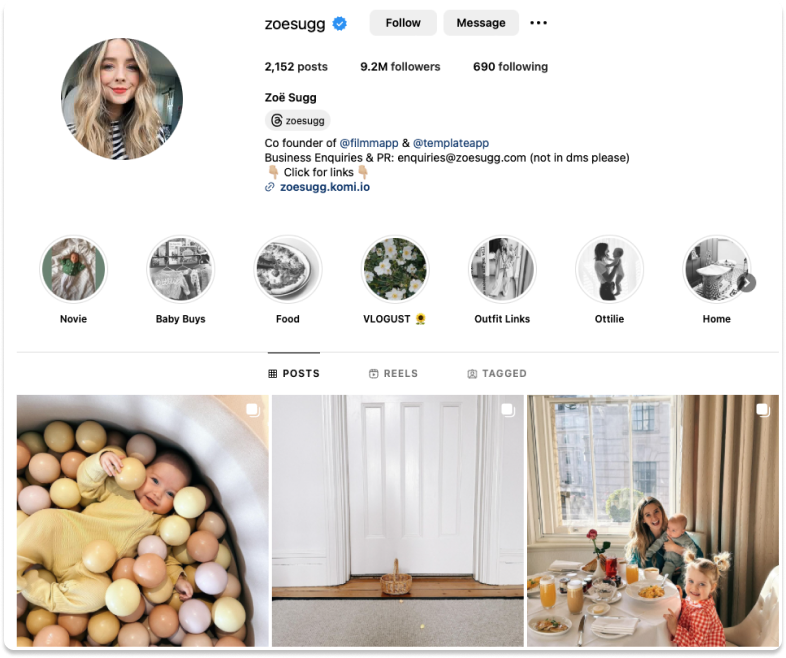
Influencer marketing PR came about in a very simple way - influencers realized that as they grew an audience, they could also grow their revenue. By sharing products and services they believed in, they could get a percentage of the profits while adding value to their target audience.
This brings us to another reason why PR influencer strategy works. Good influencers are authentic and only share products they personally use or believe in. This is why their audiences trust them and are keen to listen to their advice rather than just shrugging it off as another marketing message.
And because they have smaller audiences, influencers are an excellent way for brands to tap into niche markets. While paid ads work well, at the end of the day, they're just that - ads.
A great example of this is Daniel Wellington - once a relatively unknown brand, but nowadays, a global watch company. This is all thanks to strategic partnerships with the right influencers in the fashion and lifestyle space.
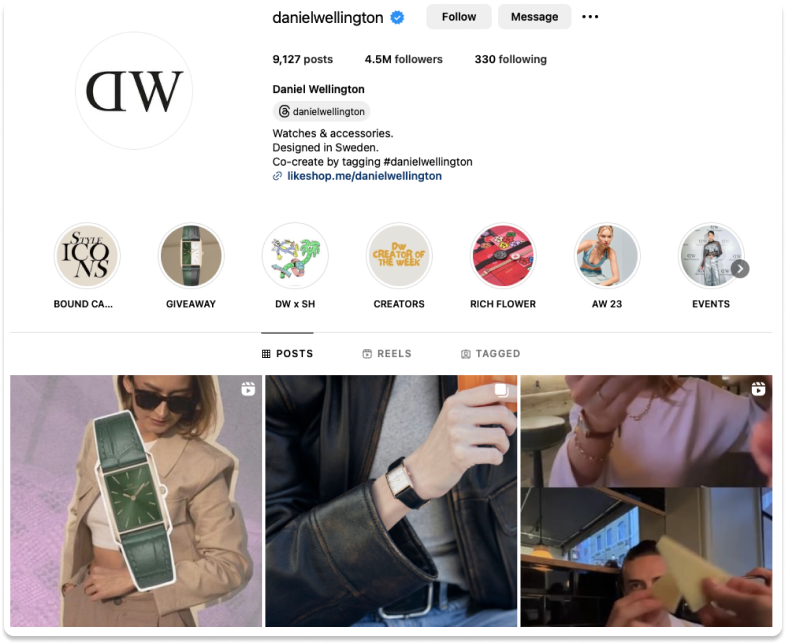
#2 Trust and authenticity
The average person sees up to 10,000 different ads per day and of course, they don't trust them. With so much advertising forced upon us, we tend not to trust any form of paid advertising. Influencer marketing, on the other hand, is all about spreading messages about your brand from genuine profiles that people trust.
#3 Benefits of influencer PR
Using influencers for your PR efforts has a range of benefits that make it a great addition to your existing tactics.
- First, you get highly targeted reach because their audience is your ideal target audience too. No other form of PR except paid ads can provide this kind of coverage.
- Second, engagement is typically high, especially if the influencer commonly has a lot of comments, likes, and shares on their content.
- Then there is the cost. Influencers charge anywhere from $10 to $10,000 per post, but your average should be somewhere around $500. With the right type of content and the right offer, this can provide a massive return on investment.
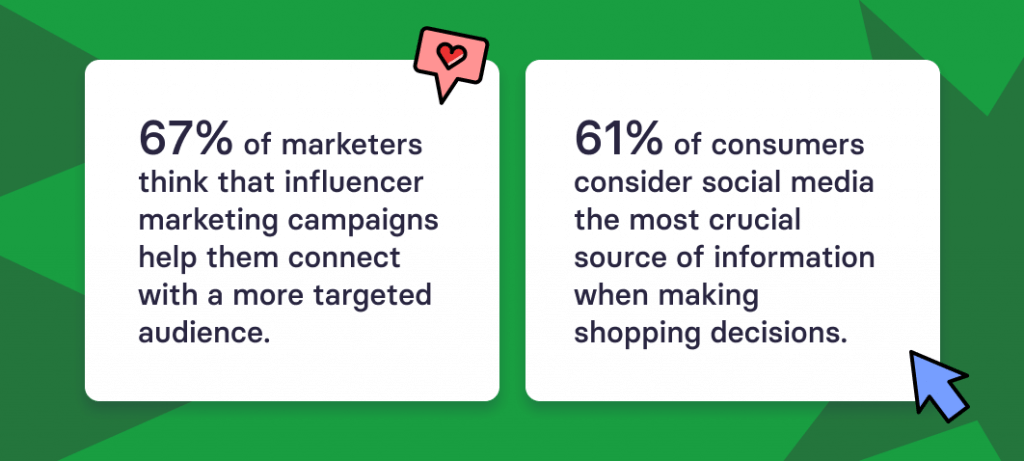
4. Last but not least, this can be a long-term, impactful strategy. Influencers tell stories through their content and can weave your offer into their narrative. They don't have to explicitly try to sell every time, which makes promotions feel less forced.
Building a successful influencer PR strategy
Setting up your influencer PR strategy properly can enhance your brand, marketing communications, and even your revenue and bottom line. When you're consciously building an influencer PR strategy, you can reach more people with authentic content, get your brand seen, and build trust and credibility with new audiences.
And in the end, that all pays off in conversions and sales.
Define your goals and objectives
Define what you want out of your relationship with an influencer first. That way, you're aligned from the start and they know if they can meet your expectations or not. Also, establish whether or not you have the budget for the job.
Some of the most common KPIs and goals for influencer PR campaigns include:
- Brand awareness increase
- Product sales
- Website or funnel conversions
- The quantity of new user-generated content
Make sure to set goals that are SMART - specific, measurable, achievable, relevant and time-bound. For example, increasing website conversions by 20% through an influencer campaign in a 30-day period.
Identify your target audience
Before hiring any PR influencer, you should know exactly who you're trying to sell to. Define your ideal target audience using some of these criteria:
- Their age range
- Their location
- Their interests (hobbies, pastimes, ways to spend disposable income)
- Their favorite social media platforms
- Their values, attitudes, and lifestyles
All of this information in one place can help you understand your target audience better. But even more importantly for our case today, this helps you find the right influencer for the job. Once you know who they are, you can run a match against the influencer's followers to see if you have the right fit.
How to choose the right influencers
There are many moving parts in PR influencer strategy and the first is the most important - choosing the right person for the job. You want to make sure they have the right metrics behind them, a target audience that matches your brand, and that they've been there before.
Step #1
The first step is to use influencer audience insights. Tools such as Modash allow you to take a deep dive in an influencer’s profile - analyzing the type of their audience, their engagement levels, their ratio of genuine and fake followers, and more.
Step #2
Then you can take a look at competitors or brands in your industry and niche. What kind of influencers do they collaborate with? You may not choose the exact same person(s), but you can draw inspiration from their choices.
Step #3
You can collect feedback from social media too - and ask your followers about their favorite accounts that they’re following. You may not find the ideal influencer immediately, but you'll get some excellent ideas and drive engagement from your audience.
Step #4
Last but not least, you can use social media listening tools, like Prowly. With a social media listening tool, you can:
- Find the right influencers for your niche
- Spot influencers who like your area but aren't deeply involved
- Identify influencers with recent reputation problems that could hurt your brand
- Discover small groups of influencers specific to your industry that you haven't found yet
What’s more, you can set up alerts for your target keywords. This will show you who uses these keywords, what their engagement levels are, who their target audience is, where that audience comes from, and much more.
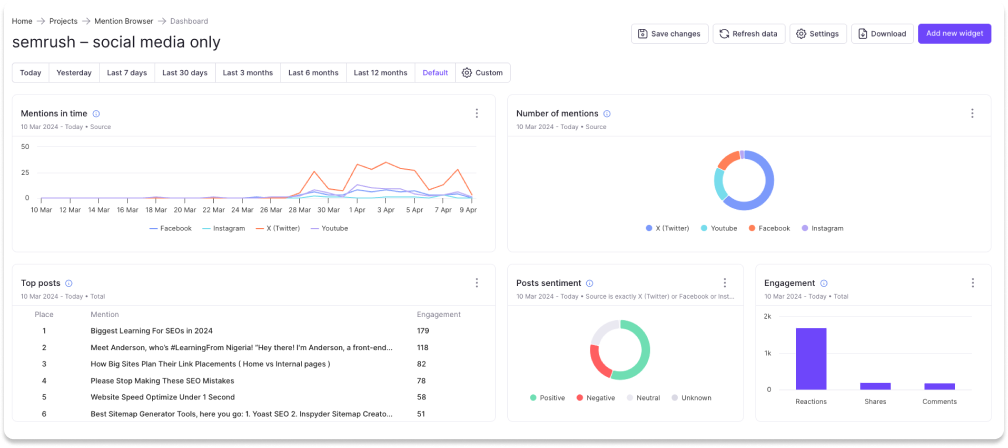
You can get notified every time someone uses your chosen keywords. You can even use this strategy to load up competitor brand names and see which public relations influencers they are using for their marketing campaigns.
Integrating influencers into your PR plan
Influencer collaborations should not be a one-off project. Instead, you can build relationships with influencers and use them to amplify every PR campaign you launch.
For example, if you have a new press release that you're pitching to journalists and bloggers, you can also use influencers as a promotional channel.
There are certain advantages of continued collaboration with influencers:
- More credibility and trust over time
- Higher reach and visibility
- More authenticity (as they're constantly talking about you)
- Ease of content creation (since it's delegated to the influencer)
- Amplified reach on social media for your business profile
However, there are some concerns you should keep in mind as well:
- High cost, as some influencers charge a lot of money for every piece of content
- Authenticity conflicts (if an influencer represents more than one brand in a certain industry)
- Limited control over the end product
- Dependency on the influencer's reputation: if they end up tarnishing their reputation over time, it affects your brand too
Weigh out the pros and cons and, most importantly, choose reputable partners you can trust in the long run.
Collaborative content creation
When you hire an influencer, you want to make sure you create content together, rather than trusting them with the entire process from start to finish. This ensures that the content is on-brand and reflects your values as well as targets the right audience.
There are many different ways you can perform collaborative content creation with influencers. Some of the most popular methods include:
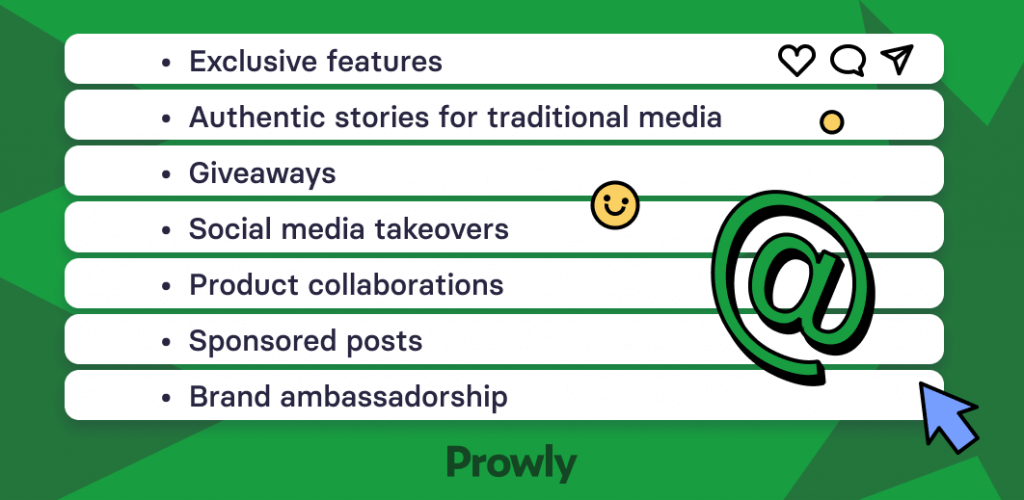
- Exclusive features - where influencers cover a unique angle in a story about your brand
- Authentic stories for traditional media - where the main aim is to gain attention from the press
- Giveaways - where the influencer gives out your products/services to their audience
- Social media takeovers - where the influencer "takes over" your account and interacts with your target audience
- Product collaborations - the influencer adds their flare to your product or service
- Sponsored posts - where the influencer openly discloses that you are paying for the content they are publishing
- Brand ambassadorship- where the influencer becomes a long-term partner who represents your brand
Monitoring and measuring success
To learn whether the influencer you hired is driving actual business results, you want to monitor their performance. And to do that, you’ll want to be aware of the key PR metrics for influencer collaboration:
- Sales: the number of direct sales driven through the collaboration. You can measure this through unique referral links, conversions through your website, and other metrics.
- Brand awareness: the number of mentions you gain on social media, which can easily be tracked with a media monitoring tool like Prowly.
- The sentiment of your new mentions: how people perceive your brand and talk about it, also easily measured with Prowly's sentiment analysis.
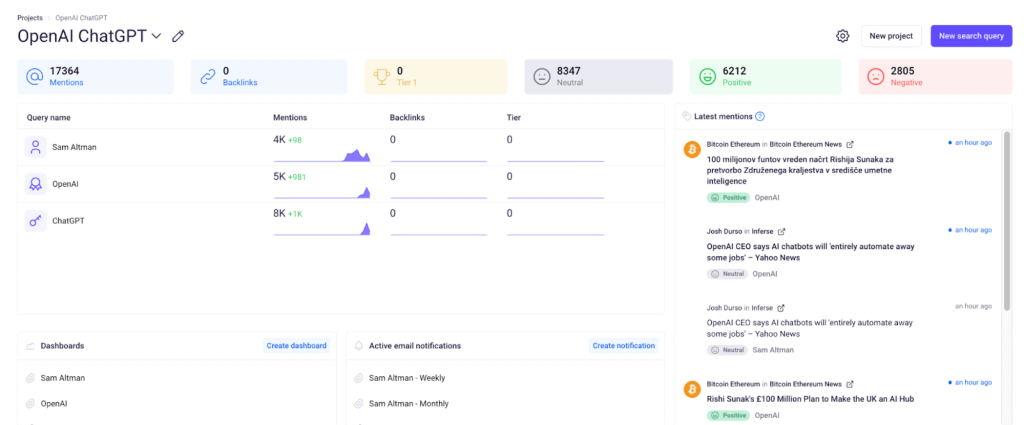
- Brand share of voice (SOV): how much space your brand occupies in your industry and how you compare to your competitors.
- Website traffic: how many new visitors come to your website as a result of cooperating with a certain influencer.
- Engagement: how many more people engage with your content thanks to the influencer's work.
There are many tools that allow you to measure the success of your PR campaigns, and Prowly helps you gather the most relevant metrics all in one place.
Navigating challenges and pitfalls in influencer PR
Collaborating with influencers is not always a walk in the park. Even if you find someone who's ideal for your brand, there are still a couple of issues you should know about before you start collaborating.
Maintaining transparency
When an influencer is representing your brand, both you and the influencer need to be transparent about it. They should make it obvious that their content is sponsored and that they are being paid to promote a product or service. Not disclosing this information can create issues not just with your target audience, but also with social media platforms that have rules against this kind of behavior.
Ensuring authenticity
The only way a campaign will work out is if the influencer truly believes in your product and its benefits. If they are shilling your product to their audience and they don't think it's good quality, it will reflect in their content and the campaign will do more harm than good for your brand.
Mitigating risks
Once you strike a deal with an influencer, you don't have too much control over the content they create. They could show your brand in a negative way in their posts, for you to see it only once the damage has already been done.
Tips for building long-term influencer relationships
Instead of one-off campaigns, it's best to build long-term relationships with influencers to make sure both sides benefit from the collaboration. Here is how to do that:
Clear communication and expectations
Communication is the foundation of every good relationship, especially when there's money involved.
- For starters, share regular updates with the influencer - about the progress of the campaign, the key metrics, changes in the product, and more. Don't leave them in the dark, because their content needs to be guided by data.
- Address concerns early. If there is a potential conflict arising, solve it quickly before it snowballs into something that will cause you to drop the collaboration.
- Use clear language when describing what you want. There is no need to be artsy - be concise and speak your mind.
- Respond promptly. The influencer has their own schedule and they appreciate your feedback when it comes in a timely manner.
Providing value and support
The influencer you work with is not alone in this partnership - so don't make them feel that way. Whenever they need help with your product's features, your target audience, pricing, customer support, or other things - be there for them. It makes their job easier and ensures both sides get the most out of the relationship.
Regular check-ins and feedback
Instead of waiting for a monthly report, check in on your influencer partners on a regular basis. Make sure they have the right briefs and collateral and enough information about what you do to make great content. Ask them if they feel stuck with something and how you can make their job easier.
Conclusion
While there are many pitfalls and obstacles to watch out for, hiring influencers for your PR campaigns can be extremely rewarding. You'll benefit from more engagement, traffic and sales, all while building authentic relationships with your target audience.
Hopefully, we helped you decide on who you hire as your next influencer partner. But even more than that, Prowly can help you see if they're the real deal. With Prowly, you can measure key PR metrics for your influencer campaigns with ease.

